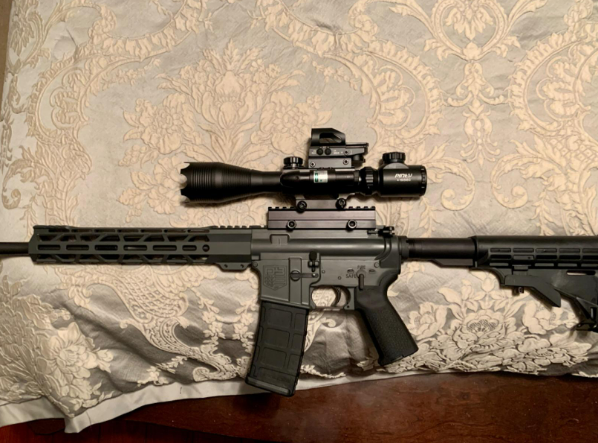Understanding MOA is essential for any serious shooter. Whether you're selecting a red dot sight, adjusting a scope for long-range shooting, or simply trying to improve your accuracy, a solid grasp of MOA principles will enhance your shooting experience. As with any skill in shooting, practice and experience are key to mastering the use of MOA in real-world scenarios.
What is MOA?Differences in MOA Dots
How does MOA affect shooting?
MOA vs. MIL (Milliradian)
(Reading Time: 9-11 Minutes)

MOA, or Minute of Angle, is an angular measurement used in shooting and ballistics, to help the shooter make adjustments to their scope so as to hit the target more accurately. “Minute” is a way to refer to 1/60th of something. For example, 1 minute of an hour is 1/60th of that hour. Therefore, we now know that 1 MOA is one-sixtieth of an angle. One MOA is equal to 1/60th of a degree, or approximately 1.047 inches at 100 yards. This measurement is used to describe the accuracy of firearms, the size of reticle dots in red dot sights, and the adjustments made on rifle scopes.
1 MOA spreads about 1″ per 100 yards. (actually 1.047″)
1 MOA is a different size at different distances, 8″ at 800 yards is still just 1 MOA.
| 100 yds | 200 yds | 300 yds | 400 yds | 500 yds | 600 yds | 700 yds | 800 yds |
| 1″ | 2″ | 3″ | 4″ | 5″ | 6″ | 7″ | 8″ |
The concept of MOA is based on the principle that as distance increases, the angle remains constant while the physical measurement expands proportionally. For example, 1 MOA at 200 yards is about 2.094 inches, and at 300 yards, it's roughly 3.141 inches. This linear relationship makes MOA a versatile and widely-used measurement in shooting.

Differences in MOA Dots
When it comes to red dot sights, the size of the dot is often expressed in MOA. Common sizes include 2 MOA, 3 MOA, and 6 MOA dots. The choice between these sizes depends on the intended use and personal preference.
2 MOA Dot vs. 6 MOA Dot:
A 2 MOA dot is smaller and more precise, covering less of the target at longer distances. This makes it ideal for shooters who prioritize accuracy and engage targets at longer ranges. At 100 yards, a 2 MOA dot will cover approximately 2 inches of the target.
In contrast, a 6 MOA dot is larger and more visible, especially in high-stress or low-light situations. It's faster to acquire in close-quarters scenarios but may obscure more of the target at longer distances. At 100 yards, a 6 MOA dot will cover about 6 inches of the target.
3 MOA vs. 6 MOA:
A 3 MOA dot offers a middle ground between the precision of a 2 MOA dot and the quick target acquisition of a 6 MOA dot. It's versatile enough for both medium-range precision shooting and faster close-quarters engagements.
The choice between 3 MOA and 6 MOA often comes down to the primary use of the firearm. For general-purpose use, many shooters find 3 MOA to be a good compromise. However, for home defense or close-range competitive shooting, the larger 6 MOA dot might be preferable.

This 1x20 red dot sight with a riser mount is here to please. Knowing that the lens is the soul of every scope, offering precision ocular and objective optics with multiple coatings to provide optimal clarity and scratch resistance at all times.
The tube between them is filled with nitrogen to offer waterproofing and protection against fog, shock, and condensation.
Pinty rifle sight has 8 brightness levels for visibility in almost all lighting conditions. The durable 6061 aluminum alloy is coated with a black anodized finish so you get a lightweight scope built to last. The convenient knob makes windage & elevation adjustment a breeze, modulating 1 MOA per click for superior precision.
Fitting any firearm with a standard 20mm Picatinny or Weaver rail thanks to a co-witness riser mount, our 3 MOA optical sight is a must-have for both handguns and long guns including rifles, carbines, shotguns, airsoft guns, bb guns, and more.
How does MOA affect shooting?
MOA stands for Minute of Angle. It is a unit of angular measurement used to adjust the rifle scope. One MOA roughly equals 1.047 inches at 100 yards, meaning you can fine-tune your point of impact by adjusting the scope in MOA increments.
1. Accuracy Measurement: MOA is used to quantify the accuracy of a firearm. A rifle capable of shooting 1 MOA groups means it can consistently place shots within a 1-inch circle at 100 yards.
2. Scope Adjustments: Rifle scopes use MOA for elevation and windage adjustments. These adjustments allow shooters to compensate for bullet drop and wind drift at various distances.
3. Range Estimation: By understanding MOA, shooters can estimate the distance to targets using their reticles, which is particularly useful in hunting or long-range shooting scenarios.
Adjusting a Scope Using MOA
Scopes with MOA adjustments typically allow you to move the reticle up, down, left, or right by specific MOA values per click. For example, if your shots are hitting 4 inches low at 100 yards and your scope adjusts in 1/4 MOA increments, you would need to make 16 clicks up (4 inches ÷ 1/4 MOA per click) to bring your point of impact to the point of aim.
1. Determine the click value of your scope (e.g., 1/4 MOA per click).
2. Calculate the necessary adjustment based on your point of impact.
3. Make the appropriate number of clicks on your scope's turrets.
MOA for Long-Range Shooting
The amount of MOA needed for long-range shooting depends on various factors, including the distance to the target, the ballistic properties of the ammunition, and environmental conditions. As a general rule, the farther the target, the more MOA adjustment will be necessary to compensate for bullet drop.
The number of MOA required depends on the distance you're shooting and your rifle’s ballistics. For long-range shooting (e.g., 1000 yards), you'll need a scope with a higher total elevation adjustment, usually 60 MOA or more, to compensate for bullet drop.
Choosing between different MOA
MOA vs. MIL (Milliradian)
MOA vs. MIL is largely a matter of preference. MOA is more precise with smaller increments, which some shooters prefer, especially in the U.S. MIL is favored by many long-range shooters due to its ease of calculation. Both work effectively; it's about what you're comfortable using.
MOA:
- More intuitive for shooters used to the imperial measurement system
- Slightly finer adjustments (1/4 MOA is slightly smaller than 1/10 MIL)
- Commonly used in the United States
MIL:
- Based on the metric system, making it more universal
- Easier mental math for some shooters (1 MIL = 10 cm at 100 meters)
- Increasingly popular in military and long-range shooting communities
The choice between MOA and MIL often comes down to personal preference and the specific shooting discipline. Both systems are capable of precise adjustments, and proficiency in either can lead to excellent results.

Calculating MOA for Specific Distances
To calculate MOA, you can use ballistic calculators, or the basic rule is that 1 MOA equals roughly 1 inch at 100 yards. So, if your shot is off by 5 inches at 100 yards, you would adjust by 5 MOA.
Determine the bullet drop at the target distance using a ballistic calculator or through empirical testing.
Convert the bullet drop to MOA using the formula: MOA = (Drop in inches / Distance in yards) × 95.5
For example, if your bullet drops 20 inches at 300 yards:
MOA = (20 / 300) × 95.5 ≈ 6.37 MOA
You would then adjust your scope up by approximately 6.5 MOA to compensate for this drop.







